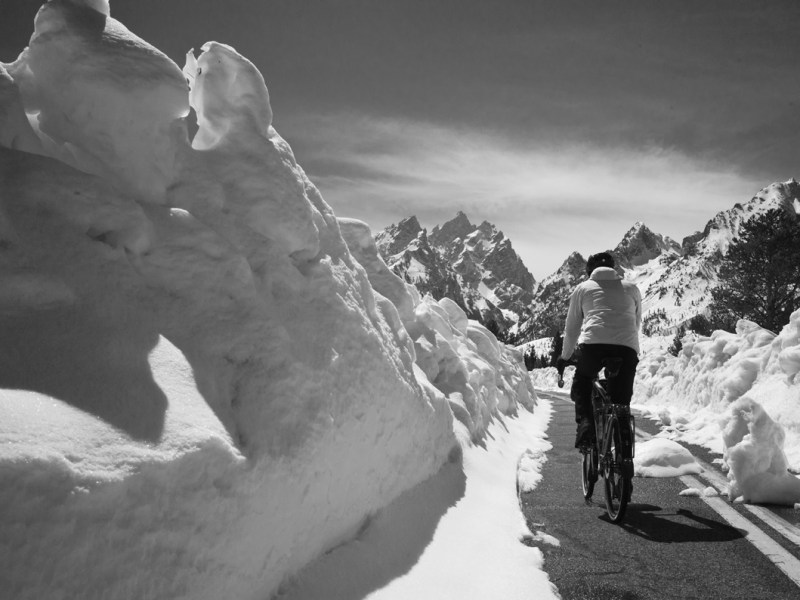Each spring, cyclists watch Yellowstone weather closely hoping for clear skies that might allow a 46-mile ride through nature without worrying about noisy, charging motor vehicles.
Park crews plow snow from the road between the West Yellowstone and Mammoth entrances, then before the route opens to vehicles, hundreds of cyclists swarm to pedal past Mount Haynes, Gibbon Falls, Roaring Mountain and dozens of lumbering bison.
This year, cycling opened April 2 between Mammoth and West Yellowstone and along a short section of the East Entrance Road outside Cody. Vehicles begin entering the park today.
“You can hear the birds singing, have a conversation without cars buzzing by you.”
Kelli Hart
Last weekend, hundreds of cyclists pedaled the blacktop, swarming the trailhead parking lots like a caddis hatch on the nearby Madison River. Unlike the uniform flies, the bicycle riders came in all shapes and sizes, from streamlined road warriors to upright tourers to Brady Bunch families with their kids’ striders.
Some make a short poke from West Yellowstone to Seven Mile Bridge, others plan a two-day, 90-mile out-and-back traverse from Mammoth with an overnight motel stop. It’s all done without the worry of being hit or run over, although limited administrative traffic also uses the route.
“It’s an amazing opportunity,” said Kelli Hart, co-owner of Freeheel and Wheel, a sporting goods store and coffee shop in West Yellowstone, Montana. “You can hear the birds singing, have a conversation without cars buzzing by you.
“A lot of people will make this an annual day or event,” she said. Cyclists come from Utah, Idaho and “all over Montana,” she said. One man flew in with his bike from Portland, Oregon, for his 11th annual ride.

With two clear days in a row, last weekend “was quite crazy and busy,” Hart said. Yellowstone rangers counted 226 cyclists between Norris and Mammoth on Saturday, said Morgan Warthin, the park’s chief of public affairs.
“We underscore for people there will be traffic on the road — utility vehicles,” she said, and that cyclists should ride single file.
Spring is the most vulnerable time for wildlife, she said, and an excursion comes with the responsibility to steer clear of bison and grizzly bears. Warthin has cycled the road several times, welcoming spring with a motorless tour.
“It was a joy,” she said, “still is.”
The name of Hart’s store was corrected on 4.19.24 — Ed.





This is indeed a fantastic visitor experience in Yellowstone. I rode through from West to Gardiner last weekend with a friend, and it’s a sublime joyful ride without the threat of motor vehicles on the road. We saw hundreds of people of all abilities, out in pods of friends and family enjoying the world’s first national park.
Unfortunately, the National Park Service, and especially Yellowstone, don’t seem to really care much about enhancing park options for people bicycling and walking. While the Mammoth-West section is open for a brief time, sadly, after decades of successful use, Yellowstone closed the south entry from Flagg Ranch for park visitors on bikes, without public input, and on the threadbare claim that there “could be a problem”.
Yellowstone should reopen the south gate in spring, and manage as needed for wildlife and human safety. The Park should celebrate this unique opportunity to provide visitors with a wonderful visit to their National Park car free.
Remember when Malcolm Wallop put forth the idea of having a monorail system in Yellowstone?
https://www.washingtonpost.com/archive/politics/1991/05/30/a-little-disney-magic-for-national-parks/d23e43d7-e783-45f0-b8b5-ca4b054cfc2a/
Think about how much nicer the park experience would be without motor vehicles. With some planning, it could be done without eliminating the opportunity for anyone.
One day they might have bike lanes. Even those might be dangerous in the summer traffic.
How about a three day road closure plan in certain sections of the park, sequenced so that bikers could traverse the park free of vehicle traffic. Do this once during the summer.